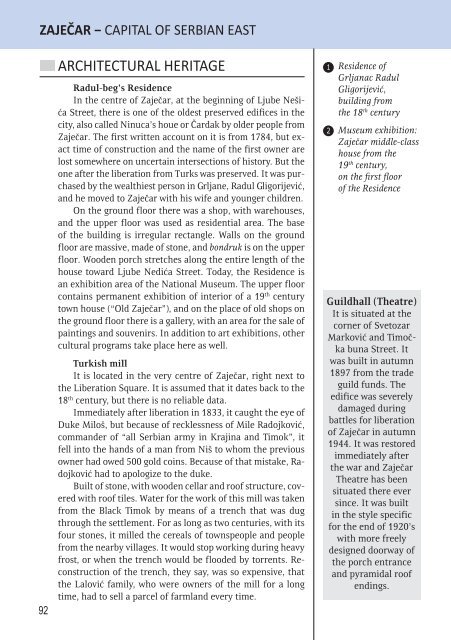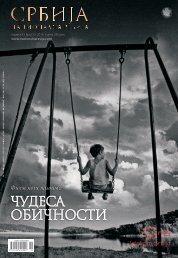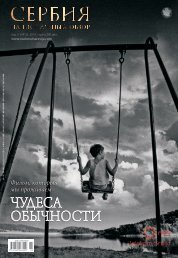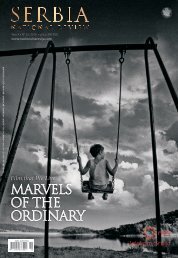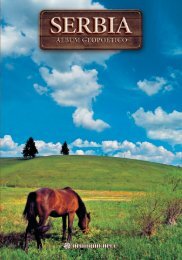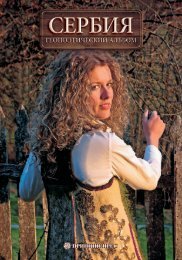Zajecar - engleski - niska rezolucija
You also want an ePaper? Increase the reach of your titles
YUMPU automatically turns print PDFs into web optimized ePapers that Google loves.
ZAJEČAR − CAPITAL OF SERBIAN EAST<br />
92<br />
ARCHITECTURAL HERITAGE<br />
Radul-be g’s Residence<br />
In the centre of Za je ča r, at the beginning of Lju be Ne šića<br />
Street, there is one of the oldest preserved edifices in the<br />
city, also called Ninuca’s houe or Čar dak by older people from<br />
Zaječar. The first written account on it is from 1784, but exact<br />
time of construction and the name of the first owner are<br />
lost somewhere on uncertain intersections of history. But the<br />
one after the liberation from Turks was preserved. It was purchased<br />
by the wealthiest person in Gr lja ne, Ra dul Gli go ri je vić,<br />
and he moved to Za je čar with his wife and younger children.<br />
On the ground floor there was a shop, with warehouses,<br />
and the upper floor was used as residential area. The base<br />
of the building is irregular rectangle. Walls on the ground<br />
floor are massive, made of stone, and bondruk is on the upper<br />
floor. Wooden porch stretches along the entire length of the<br />
house toward Ljube Nedića Street. Today, the Residence is<br />
an exhibition area of the National Museum. The upper floor<br />
contains permanent exhibition of interior of a 19 th century<br />
town house (“Old Za je čar”), and on the place of old shops on<br />
the ground floor there is a gallery, with an area for the sale of<br />
paintings and souvenirs. In addition to art exhibitions, other<br />
cultural programs take place here as well.<br />
Turkish mill<br />
It is located in the very centre of Za je ča r, right next to<br />
the Liberation Square. It is assumed that it dates back to the<br />
18 th century, but there is no reliable data.<br />
Immediately after liberation in 1833, it caught the eye of<br />
Duke Mi lo š, but because of recklessness of Mi le Ra doj ko vi ć,<br />
commander of “all Serbian army in Kraj i na and Ti mo k”, it<br />
fell into the hands of a man from Niš to whom the previous<br />
owner had owed 500 gold coins. Because of that mistake, Radoj<br />
ko vić had to apologize to the duke.<br />
Built of stone, with wooden cellar and roof structure, covered<br />
with roof tiles. Water for the work of this mill was taken<br />
from the Black Timok by means of a trench that was dug<br />
through the settlement. For as long as two centuries, with its<br />
four stones, it milled the cereals of townspeople and people<br />
from the nearby villages. It would stop working during heavy<br />
frost, or when the trench would be flooded by torrents. Reconstruction<br />
of the trench, they say, was so expensive, that<br />
the La lo vić family, who were owners of the mill for a long<br />
time, had to sell a parcel of farmland every time.<br />
1<br />
2<br />
Residence of<br />
Gr ljanac Ra du l<br />
Gli go ri je vi ć,<br />
building from<br />
the 18 th century<br />
Museum exhibition:<br />
Za je čar middle-class<br />
house from the<br />
19 th century,<br />
on the first floor<br />
of the Residence<br />
Guildhall (Theatre)<br />
It is situated at the<br />
corner of Sve to za r<br />
Mar ko vi ć and Ti močka<br />
bu na Street. It<br />
was built in autumn<br />
1897 from the trade<br />
guild funds. The<br />
edifice was severely<br />
damaged during<br />
battles for liberation<br />
of Za je ča r in autumn<br />
1944. It was restored<br />
immediately after<br />
the war and Zaječar<br />
Theatre has been<br />
situated there ever<br />
since. It was built<br />
in the style specific<br />
for the end of 1920’s<br />
with more freely<br />
designed doorway of<br />
the porch entrance<br />
and pyramidal roof<br />
endings.


